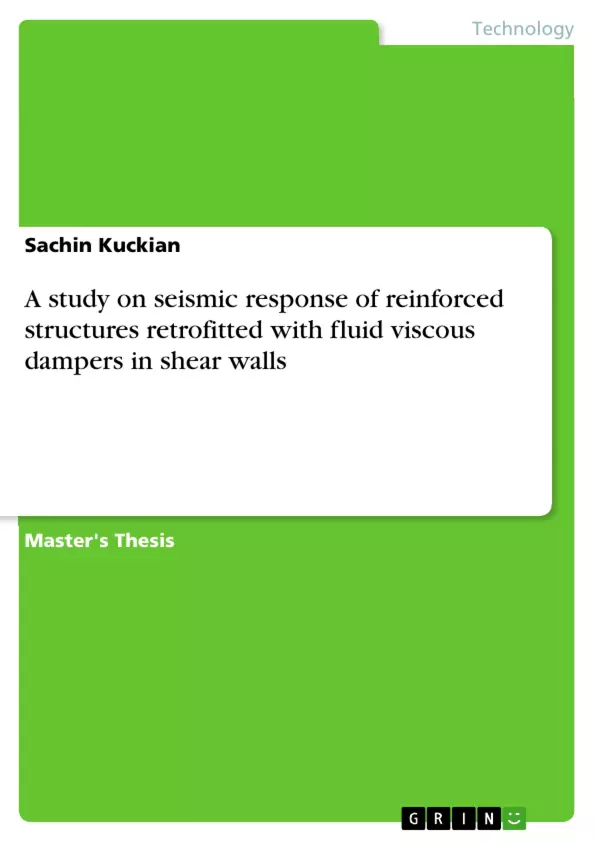The present study investigates the seismic behavior of multi-story building using damping devices strategically located within the lateral load resisting elements. It concentrates on a retrofitting strategy with passive energy dissipation device known as Fluid Viscous Damper (FVD) which will be applicable to new design as well as retrofitting existing buildings to ensure seismic safety by fitting damping devices which can transform a wall panel into a damping element. The first study involves analysis of a nine-story model having cut-outs and the use of the dampers of different configuration in these structures. The second study involves the use the diagonal brace configuration dampers provided in the cutout sections of 2D 9, 18, 27 storey structures and 3D 27 storey with core wall structure at three consecutive story levels each. For the second study, the cut out locations is varied depending on their relative positions. The relative position is the ratio of the total height of the structure to the upper edge of the topmost cut-out.
These structures were initially modeled and time history analysis was performed on the structure without FVD and the structure retrofitted with FVD. Three different ground motions were used for the analysis. Results of the un- retrofitted structures are then compared with a retrofitted structure in terms of peak story displacements, roof accelerations, and pseudo-spectral accelerations.
Study shows that there has been a significant reduction in seismic demands for a structure retrofitted with FVD in terms of peak storey displacements, pseudo-spectral accelerations and roof accelerations when the dampers are placed at lower three cut outs i.e. with high relative position. It is also observed that damping coefficient value obtained is least for upper toggle-brace configuration out of the four different damper configurations and with maximum reduction compared to other configurations. For modeling and analysis purpose the software SAP2000® is used.
Through the study it could be concluded that FVD significantly reduces the seismic demands of the structure in terms of peak storey displacements, pseudo-spectral accelerations and roof accelerations. This suggests that FVDs can be efficiently used in retrofitting. Also damping coefficient value obtained is least for upper toggle-brace configuration out of the four different damper configurations suggesting this is the most efficient configuration for retrofitting.
Inhaltsverzeichnis (Table of Contents)
- Chapter 1
- INTRODUCTION
- General
- Modes of failure of Reinforced concrete shear walls
- Different retrofitting techniques for RC shear walls
- Motivation of study
- Objective of work
- Organization of report
- Chapter 2
- LITERATURE REVIEW
- Introduction
- Introduction to the project title
- Literature review
- Summarized outcome of the literature review
- Conclusion
- Chapter 3
- METHODOLOGY
- Introduction
- Methodology followed
- Model description
- Chapter 4
- RESULT ANALYSIS
- Introduction
- Results and discussions for 9 storey structure with different configuration
- Results for 9, 18 and 27,3d core 27 storey structures
- Chapter 5
- CONCLUSION AND FUTURE SCOPE OF WORK
- Brief summary of work
- Conclusion
- Future scope of work
- REFERENCES
- PROJECT DETAILS
Zielsetzung und Themenschwerpunkte (Objectives and Key Themes)
This report examines the seismic behavior of multi-storey buildings equipped with damping devices strategically placed within the lateral load resisting elements. The primary objective is to investigate the effectiveness of Fluid Viscous Dampers (FVDs) in retrofitting existing buildings and enhancing the seismic performance of new construction. The study focuses on utilizing these passive energy dissipation devices to transform wall panels into damping elements, ensuring seismic safety.
- Seismic retrofitting of reinforced concrete (RC) shear walls using Fluid Viscous Dampers (FVDs)
- Impact of damper configuration and placement on the seismic performance of structures
- Analysis of the effectiveness of FVDs in reducing seismic demands, such as peak storey displacements, pseudo spectral accelerations, and roof accelerations
- Comparison of the seismic behavior of retrofitted structures with different damper configurations and placement strategies
- Evaluation of the damping coefficient values for different FVD configurations
Zusammenfassung der Kapitel (Chapter Summaries)
- Chapter 1: INTRODUCTION
This chapter provides an overview of the study, addressing the problem of seismic vulnerability in tall structures and the importance of retrofitting. It outlines the modes of failure in RC shear walls, various retrofitting techniques, and the motivation behind this specific study. The objective and organization of the report are also presented.
- Chapter 2: LITERATURE REVIEW
This chapter presents a comprehensive review of existing literature on the topic. It introduces the project title and explores various research findings related to seismic retrofitting techniques for RC shear walls, particularly focusing on the application of fluid viscous dampers. The chapter concludes with a summarized outcome of the literature review.
- Chapter 3: METHODOLOGY
This chapter delves into the methodology employed in the study. It describes the modeling approach, the specific structures analyzed, and the selection of ground motions for the time history analysis. The chapter details the inclusion of FVDs in the model and the variation of their configuration and placement to assess their effectiveness.
- Chapter 4: RESULT ANALYSIS
This chapter presents the results and analysis of the seismic performance of the structures with and without FVDs. It examines the impact of different damper configurations on peak storey displacements, roof accelerations, and pseudo spectral accelerations. The chapter discusses the findings for various building configurations, including nine-story structures with cut-outs and 2D and 3D structures with core walls.
Schlüsselwörter (Keywords)
The key focus areas of this study encompass seismic retrofitting, reinforced concrete shear walls, Fluid Viscous Dampers (FVDs), passive energy dissipation, seismic performance, time history analysis, peak storey displacements, pseudo spectral accelerations, roof accelerations, damper configuration, damper placement, and damping coefficient.
- Quote paper
- Sachin Kuckian (Author), 2015, A study on seismic response of reinforced structures retrofitted with fluid viscous dampers in shear walls, Munich, GRIN Verlag, https://www.grin.com/document/496594



